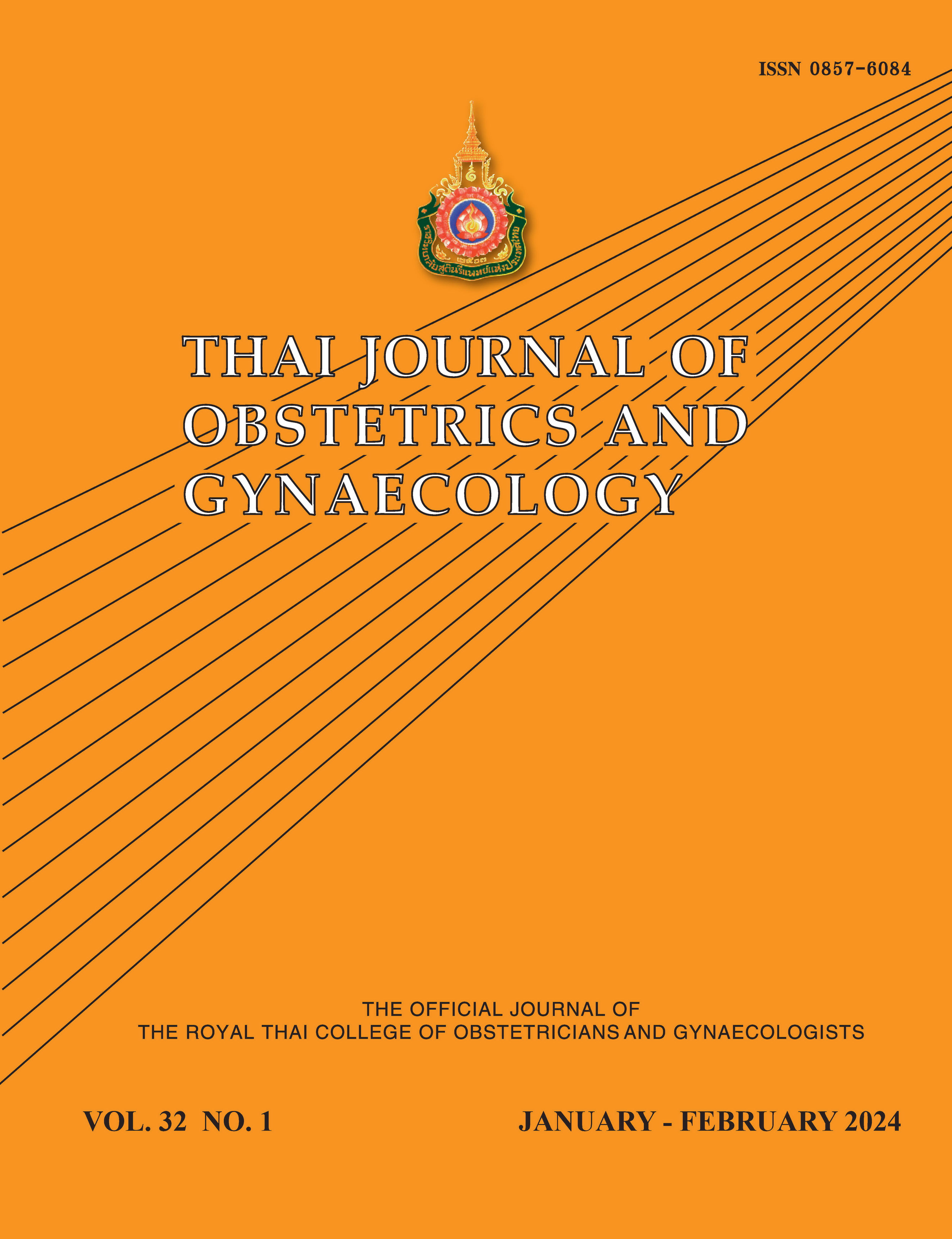Cut-off Levels of Visceral Adiposity Index for Determining Hyperandrogenemia in Women with Polycystic Ovary Syndrome
Main Article Content
Abstract
Objectives: To evaluate the optimum cut-off values and AUC of visceral adiposity index (VAI) and lipid accumulation product (LAP) to predict hyperandrogenemia in Thai polycystic ovary syndrome (PCOS) women and to identify factors that associated with these values.
Materials and Methods: This prospective cross-sectional study recruited 102 Thai PCOS women, aged 18-45 years. All participants were measured for anthropometric data, lipid, carbohydrate and androgen profiles. VAI, LAP and free testosterone were calculated. The receiver operating characteristics (ROC) curve was performed to evaluate the optimum cut-off values of VAI and LAP in predicting hyperandrogenemia, and also to identify factors associated with VAI and LAP.
Results: The mean ± standard deviation of age was 26.9 ± 5.7 years. Prevalence of hyperandrogenemia was 49%. The optimal cut-off values of VAI and LAP in predicting hyperandrogenemia were ≥ 1 (AUC = 0.755) and ≥ 16.5 (AUC = 0.756) respectively. VAI was positively correlated with LAP, hip circumference (HC), waist-to-hip ratio (WHR), the waist-to-height ratio and low density lipoprotein-cholesterol. LAP was significantly correlated with HC, waist circumference, and WHR. Both LAP and VAI were significantly correlated with free testosterone and free androgen index (FAI), but not correlated with total testosterone and dehydroepiandiosterone sulfate.
Conclusion: Both VAI and LAP were significantly correlated with free testosterone and FAI. A VAI value of ≥1 and a LAP value of ≥ 16.5 were determined to be indicators for predicting hyperandrogenemia in PCOS women.
Article Details

This work is licensed under a Creative Commons Attribution-NonCommercial-NoDerivatives 4.0 International License.
References
Rosenfield RL, Ehrmann DA. The pathogenesis of polycystic ovary syndrome (PCOS): The hypothesis of PCOS as functional ovarian hyperandrogenism revisited. Endocr Rev 2016;37:467-520.
Teede HJ, Misso ML, Costello MF, Dokras A, Laven J, Moran L, et al. Recommendations from the international evidence-based guideline for the assessment and management of polycystic ovary syndrome. Hum Reprod 2018;33:1602-18.
Escobar-Morreale HF, San Millan JL. Abdominal adiposity and the polycystic ovary syndrome. Trends Endocrinol Metab 2007;18:266-72.
Fritz M, Speroff L. Hormone biosynthesis, metabolism, and mechanism of action. In: Fritz M, Speroff L, editors. Clinical gynecologic endocrinology and infertility. 8th ed. Philadelphia: Lippincott: Williams & Wilkins 2011. 29-104.
Pasquali R. Obesity and androgens: facts and perspectives. Fertil Steril 2006;85:1319-40.
Shuster A, Patlas M, Pinthus JH, Mourtzakis M. The clinical importance of visceral adiposity: a critical review of methods for visceral adipose tissue analysis. Br J Radiol 2012;85:1-10.
Wajchenberg BL. Subcutaneous and visceral adipose tissue: their relation to the metabolic syndrome. Endocr Rev 2000;21:697-738.
Amato MC, Giordano C. Visceral adiposity index: an indicator of adipose tissue dysfunction. Int J Endocrinol 2014;2014:730827.
Kahn HS. The “lipid accumulation product” performs better than the body mass index for recognizing cardiovascular risk: a population-based comparison. BMC Cardiovasc Disord 2005;5:26.
Agrawal H, Aggarwal K, Jain A. Visceral adiposity index: simple tool for assessing cardiometabolic risk in women with polycystic ovary syndrome. Indian J Endocrinol Metab 2019;23:232-7.
Amato MC, Guarnotta V, Forti D, Donatelli M, Dolcimascolo S, Giordano C. Metabolically healthy polycystic ovary syndrome (MH-PCOS) and metabolically unhealthy polycystic ovary syndrome (MU-PCOS): a comparative analysis of four simple methods useful for metabolic assessment. Hum Reprod 2013;28:1919-28.
Androulakis, II, Kandaraki E, Christakou C, Karachalios A, Marinakis E, Paterakis T, et al. Visceral adiposity index (VAI) is related to the severity of anovulation and other clinical features in women with polycystic ovary syndrome. Clin Endocrinol (Oxf) 2014;81:426-31.
Techatraisak K, Wongmeerit K, Dangrat C, Wongwananuruk T, Indhavivadhana S. Measures of body adiposity and visceral adiposity index as predictors of metabolic syndrome among Thai women with PCOS. Gynecol Endocrinol 2016;32:276-80.
Aboelnaga MM, Elshahawy H. Visceral adiposity index correlation with Rotterdam criteria in patients with polycystic ovary syndrome. Int J Reprod Contracept Obstet Gynecol 2016;5:2553-60.
Rotterdam EA-SPcwg. Revised 2003 consensus on diagnostic criteria and long-term health risks related to polycystic ovary syndrome (PCOS). Hum Reprod 2004;19:41-7.
Hohl A, Ronsoni MF, Oliveira M. Hirsutism: diagnosis and treatment. Arq Bras Endocrinol Metabol 2014;58:97-107.
Speroff L, Fritz M. Hirsutism. In: Speroff L, Fritz M, editors. Clinical gynecologic endocrinology and infertility. 7th ed. Philadelphia: Lippincott: Williams & Wilkins 2005. 499-530.
Vermeulen A, Verdonck L, Kaufman JM. A critical evaluation of simple methods for the estimation of free testosterone in serum. J Clin Endocrinol Metab 1999;84:3666-72.
Tan CE, Ma S, Wai D, Chew SK, Tai ES. Can we apply the National Cholesterol Education Program Adult Treatment Panel definition of the metabolic syndrome to Asians? Diabetes Care 2004;27:1182-6.
Hatami H, Montazeri SA, Hashemi N, Ramezani Tehrani F. Optimal cutoff points for anthropometric variables to predict insulin resistance in polycystic ovary syndrome. Int J Endocrinol Metab 2017;15:e12353.
Leerasiri P, Wongwananuruk T, Indhavivadhana S, Techatraisak K, Rattanachaiyanont M, Angsuwathana S. Correlation of clinical and biochemical hyperandrogenism in Thai women with polycystic ovary syndrome. J Obstet Gynaecol Res 2016;42:678-83.
Pasquali R, Zanotti L, Fanelli F, Mezzullo M, Fazzini A, Morselli Labate AM, et al. Defining hyperandrogenism in women with polycystic ovary syndrome: A challenging perspective. J Clin Endocrinol Metab 2016;101:2013-22.


